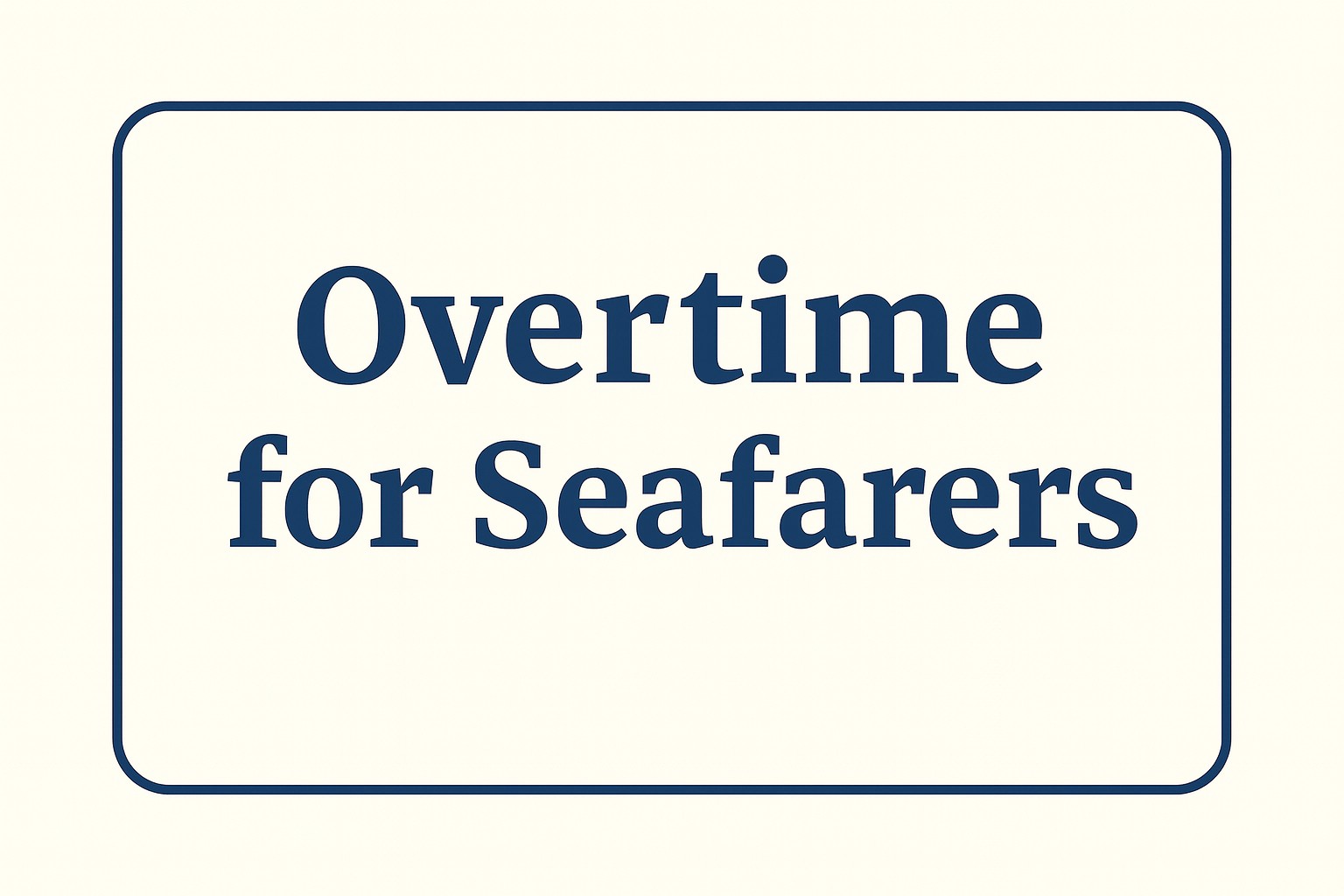
Overtime for Seafarers: How It’s Paid and Why Officers Don’t Receive Extra
Under a seafarer’s employment agreement, overtime refers to working hours in excess of the normal working time, as defined by the Maritime Labour Convention (MLC 2006) and the International Labour Organization (ILO).The standard working time is 8 hours per day or 48 hours per week.
Any time worked beyond this limit is considered overtime and must be paid separately.MLC Regulation 2.2 and Guideline B2.2.2 clearly state:
“The rate of overtime shall be not less than one and one-quarter times the basic hourly rate of pay.”
In simple terms, if a seafarer’s regular rate is $4 per hour, overtime must be paid at least at $5 per hour.
This is an international minimum standard, and every shipowner is legally obliged to comply.
How ILO Recommends Calculating Overtime
According to the latest ILO Minimum Wage Table (effective 1 January 2025):
Able Seaman (AB) – Basic wage: USD 673 per month
Hourly rate: ≈ USD 4.04
Overtime rate: 4.04 × 1.25 = USD 5.05/hour
MLC allows up to 104 hours of guaranteed overtime per month (MLC A2.3.5 and B2.2.2).
That equals roughly USD 421 extra pay.
So, an AB earns around USD 1,180 per month including overtime.
ILO Min Wage 1st January 2025 …
The ILO guideline also states:“Overtime shall be compensated at not less than 1.25 times the basic rate.
Records of all overtime worked shall be maintained and signed by both the seafarer and the master.”
Thus, overtime must not only be paid but also properly recorded and confirmed by both parties.
Why Overtime Differs Between Officers and Ratings
This is where most of the confusion begins.Ratings — such as ABs, oilers, and stewards — usually have clear watch hours, and every additional hour is measurable.
Their contracts normally include a Guaranteed Overtime (GOT) clause — commonly 85 to 103 hours per month — which is paid on top of their basic wage.Officers, however — masters, chief engineers, and senior deck or engine officers — work under a different system known as a consolidated wage.
This means their monthly salary already includes:
payment for overtime,
work on weekends and public holidays,
night watches and port duties.
For example, under the 2025 ILO wage table:
Chief Engineer — USD 2,061 basic wage + USD 1,288 overtime = USD 3,619 per month.
This is a fixed consolidated amount — not paid per hour.
Why Officers Don’t Receive Separate Overtime Pay
Nature of responsibility.
Officers are responsible for safety, leadership, and ship management — their duties are not limited to a fixed shift. It’s therefore impractical to measure overtime by hours.Contract type.
MLC allows “consolidated wages” if this is clearly stated in the employment contract:“A consolidated wage may include compensation for all overtime hours which are worked.” — MLC Guideline B2.2.2
Collective Bargaining Agreements (CBA).
ITF/IMEC and other CBAs state explicitly:“Officers’ wages are consolidated and include compensation for work performed outside normal hours.”
Industry tradition.
Officer ranks are salaried positions — higher pay compensates for flexible schedules, irregular hours, and leadership duties.
What MLC and ILO Require
📘 Normal working week: 48 hours
📘 Maximum: 72 hours per week / 14 hours per day
📘 Rest: Minimum 10 hours in every 24 hours
📘 Overtime rate: ≥ 1.25 × basic hourly rate
📘 Records: Overtime must be recorded and signed by both the master and the seafarerIf a company fails to record working/rest hours or denies proper rest, it violates MLC 2006, regardless of the rank.
Union Position and Enforcement
The International Transport Workers’ Federation (ITF) emphasizes that:
Every contract must clearly specify whether overtime is included in the salary or paid separately;
Each hour beyond the 48-hour week must be logged and compensated;
Crew members should never face retaliation for reporting excessive working hours;
MLC inspectors must verify both the wage breakdown and the work/rest hour records.
This ensures fairness, transparency, and compliance with international labour rights.
Example Calculations
2nd Engineer (Officer) | Consolidated | 1,172 + 733 = ≈ 2,059 USD | Overtime included in salary
Chief Engineer | Fully Fixed | 2,061 + 1,288 = ≈ 3,619 USD | No separate hourly record
Why Every Seafarer Should Know This
Read your contract carefully.
If it says “consolidated wage includes overtime” — there will be no separate payment.Check for a Guaranteed Overtime clause.
It secures your right to paid overtime hours.Respect rest hour limits.
MLC allows a maximum of 14 hours per day and 72 hours per week — your rest is a legal right.Keep accurate records.
Signed work/rest hour sheets are the best proof of overtime performed.
Conclusion
The difference between officers and ratings in overtime pay lies not in the value of their work — but in the structure of their contracts.
Overtime is always compensation for additional hours — either paid separately (ratings) or built into a higher fixed wage (officers).ILO and MLC define the core principles:
minimum overtime rate 1.25 × basic hourly rate,
maximum 72 hours per week,
full record of all hours worked and rest taken.
When contracts follow these standards, seafarers can be confident they are being paid fairly, transparently, and in full compliance with international maritime law.




